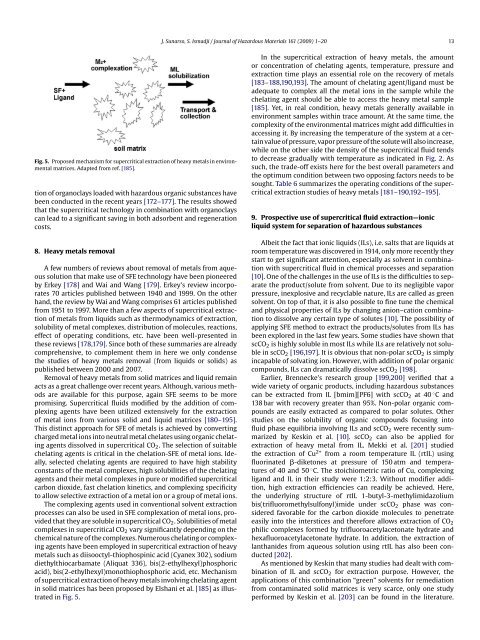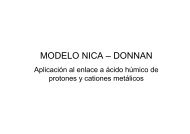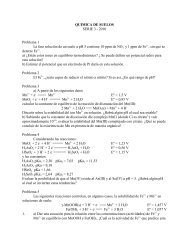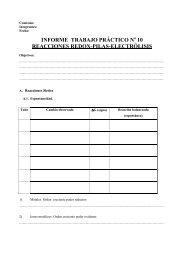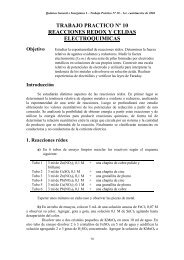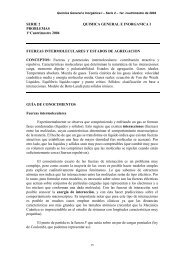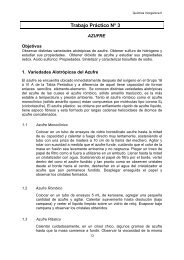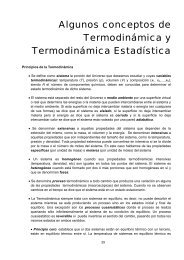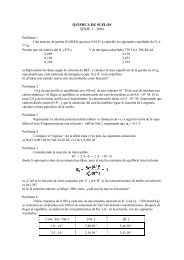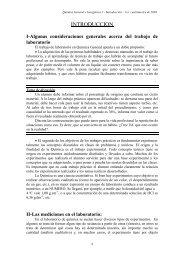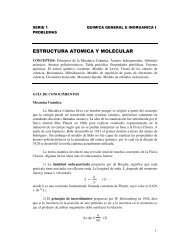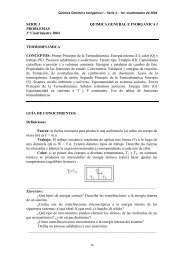Journal of Hazardous Materials Decontamination of hazardous ...
Journal of Hazardous Materials Decontamination of hazardous ...
Journal of Hazardous Materials Decontamination of hazardous ...
Create successful ePaper yourself
Turn your PDF publications into a flip-book with our unique Google optimized e-Paper software.
J. Sunarso, S. Ismadji / <strong>Journal</strong> <strong>of</strong> <strong>Hazardous</strong> <strong>Materials</strong> 161 (2009) 1–20 13Fig. 5. Proposed mechanism for supercritical extraction <strong>of</strong> heavy metals in environmentalmatrices. Adapted from ref. [185].tion <strong>of</strong> organoclays loaded with <strong>hazardous</strong> organic substances havebeen conducted in the recent years [172–177]. The results showedthat the supercritical technology in combination with organoclayscan lead to a significant saving in both adsorbent and regenerationcosts.8. Heavy metals removalA few numbers <strong>of</strong> reviews about removal <strong>of</strong> metals from aqueoussolution that make use <strong>of</strong> SFE technology have been pioneeredby Erkey [178] and Wai and Wang [179]. Erkey’s review incorporates70 articles published between 1940 and 1999. On the otherhand, the review by Wai and Wang comprises 61 articles publishedfrom 1951 to 1997. More than a few aspects <strong>of</strong> supercritical extraction<strong>of</strong> metals from liquids such as thermodynamics <strong>of</strong> extraction,solubility <strong>of</strong> metal complexes, distribution <strong>of</strong> molecules, reactions,effect <strong>of</strong> operating conditions, etc. have been well-presented inthese reviews [178,179]. Since both <strong>of</strong> these summaries are alreadycomprehensive, to complement them in here we only condensethe studies <strong>of</strong> heavy metals removal (from liquids or solids) aspublished between 2000 and 2007.Removal <strong>of</strong> heavy metals from solid matrices and liquid remainacts as a great challenge over recent years. Although, various methodsare available for this purpose, again SFE seems to be morepromising. Supercritical fluids modified by the addition <strong>of</strong> complexingagents have been utilized extensively for the extraction<strong>of</strong> metal ions from various solid and liquid matrices [180–195].This distinct approach for SFE <strong>of</strong> metals is achieved by convertingcharged metal ions into neutral metal chelates using organic chelatingagents dissolved in supercritical CO 2 . The selection <strong>of</strong> suitablechelating agents is critical in the chelation-SFE <strong>of</strong> metal ions. Ideally,selected chelating agents are required to have high stabilityconstants <strong>of</strong> the metal complexes, high solubilities <strong>of</strong> the chelatingagents and their metal complexes in pure or modified supercriticalcarbon dioxide, fast chelation kinetics, and complexing specificityto allow selective extraction <strong>of</strong> a metal ion or a group <strong>of</strong> metal ions.The complexing agents used in conventional solvent extractionprocesses can also be used in SFE complexation <strong>of</strong> metal ions, providedthat they are soluble in supercritical CO 2 . Solubilities <strong>of</strong> metalcomplexes in supercritical CO 2 vary significantly depending on thechemical nature <strong>of</strong> the complexes. Numerous chelating or complexingagents have been employed in supercritical extraction <strong>of</strong> heavymetals such as diisooctyl-thiophospinic acid (Cyanex 302), sodiumdiethylthiocarbamate (Aliquat 336), bis(2-ethylhexyl)phosphoricacid), bis(2-ethylhexyl)monothiophosphoric acid, etc. Mechanism<strong>of</strong> supercritical extraction <strong>of</strong> heavy metals involving chelating agentin solid matrices has been proposed by Elshani et al. [185] as illustratedin Fig. 5.In the supercritical extraction <strong>of</strong> heavy metals, the amountor concentration <strong>of</strong> chelating agents, temperature, pressure andextraction time plays an essential role on the recovery <strong>of</strong> metals[183–188,190,193]. The amount <strong>of</strong> chelating agent/ligand must beadequate to complex all the metal ions in the sample while thechelating agent should be able to access the heavy metal sample[185]. Yet, in real condition, heavy metals generally available inenvironment samples within trace amount. At the same time, thecomplexity <strong>of</strong> the environmental matrices might add difficulties inaccessing it. By increasing the temperature <strong>of</strong> the system at a certainvalue <strong>of</strong> pressure, vapor pressure <strong>of</strong> the solute will also increase,while on the other side the density <strong>of</strong> the supercritical fluid tendsto decrease gradually with temperature as indicated in Fig. 2. Assuch, the trade-<strong>of</strong>f exists here for the best overall parameters andthe optimum condition between two opposing factors needs to besought. Table 6 summarizes the operating conditions <strong>of</strong> the supercriticalextraction studies <strong>of</strong> heavy metals [181–190,192–195].9. Prospective use <strong>of</strong> supercritical fluid extraction—ionicliquid system for separation <strong>of</strong> <strong>hazardous</strong> substancesAlbeit the fact that ionic liquids (ILs), i.e. salts that are liquids atroom temperature was discovered in 1914, only more recently theystart to get significant attention, especially as solvent in combinationwith supercritical fluid in chemical processes and separation[10]. One <strong>of</strong> the challenges in the use <strong>of</strong> ILs is the difficulties to separatethe product/solute from solvent. Due to its negligible vaporpressure, inexplosive and recyclable nature, ILs are called as greensolvent. On top <strong>of</strong> that, it is also possible to fine tune the chemicaland physical properties <strong>of</strong> ILs by changing anion–cation combinationto dissolve any certain type <strong>of</strong> solutes [10]. The possibility <strong>of</strong>applying SFE method to extract the products/solutes from ILs hasbeen explored in the last few years. Some studies have shown thatscCO 2 is highly soluble in most ILs while ILs are relatively not solublein scCO 2 [196,197]. It is obvious that non-polar scCO 2 is simplyincapable <strong>of</strong> solvating ion. However, with addition <strong>of</strong> polar organiccompounds, ILs can dramatically dissolve scCO 2 [198].Earlier, Brennecke’s research group [199,200] verified that awide variety <strong>of</strong> organic products, including <strong>hazardous</strong> substancescan be extracted from IL [bmim][PF6] with scCO 2 at 40 ◦ C and138 bar with recovery greater than 95%. Non-polar organic compoundsare easily extracted as compared to polar solutes. Otherstudies on the solubility <strong>of</strong> organic compounds focusing int<strong>of</strong>luid phase equilibria involving ILs and scCO 2 were recently summarizedby Keskin et al. [10]. scCO 2 can also be applied forextraction <strong>of</strong> heavy metal from IL. Mekki et al. [201] studiedthe extraction <strong>of</strong> Cu 2+ from a room temperature IL (rtIL) usingfluorinated -diketones at pressure <strong>of</strong> 150 atm and temperatures<strong>of</strong> 40 and 50 ◦ C. The stoichiometric ratio <strong>of</strong> Cu, complexingligand and IL in their study were 1:2:3. Without modifier addition,high extraction efficiencies can readily be achieved. Here,the underlying structure <strong>of</strong> rtIL 1-butyl-3-methylimidazoliumbis(trifluoromethylsulfonyl)imide under scCO 2 phase was consideredfavorable for the carbon dioxide molecules to penetrateeasily into the interstices and therefore allows extraction <strong>of</strong> CO 2philic complexes formed by trifluoroacetylacetonate hydrate andhexafluoroacetylacetonate hydrate. In addition, the extraction <strong>of</strong>lanthanides from aqueous solution using rtIL has also been conducted[202].As mentioned by Keskin that many studies had dealt with combination<strong>of</strong> IL and scCO 2 for extraction purpose. However, theapplications <strong>of</strong> this combination “green” solvents for remediationfrom contaminated solid matrices is very scarce, only one studyperformed by Keskin et al. [203] can be found in the literature.


